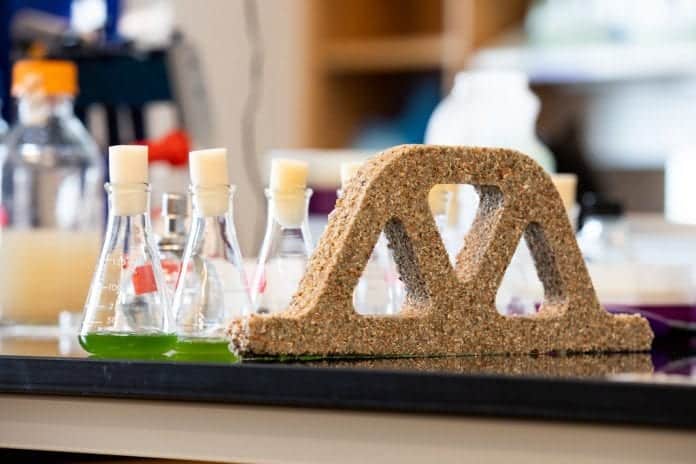
New Living Concrete using cyanobacteria – ‘A Frankenstein material’.
Scientists create living concrete that is alive and can even reproduce.
Concrete has been made the same way by the builders for centuries, i.e., by mixing hard materials like sand with various binders and hoping for it to stay rigid and fixed for a long time.
At the University of Colorado, Boulder, an interdisciplinary team of researchers have now created concrete that is alive and can even reproduce, a different kind of concrete.
Cyanobacteria, a common class of microbes that through photosynthesis, captures energy is the mineral used in the new material. Carbon dioxide is absorbed in the photosynthetic process in contrast to the huge amounts of greenhouse gas spewed by the production of regular concrete.
Another unusual feature of this concrete is the photosynthetic bacteria giving a green color to the concrete (The green color fades as the material dries). A structural engineer and the head of the research project, Wil Srubar said, “It really does look like a Frankenstein material.”
At the University of Strathclyde, in Scotland, a concrete expert, Andrea Hamilton said that the new concrete represents a new and exciting class of low-carbon.
To create the living
concrete, the scientists first tried putting cyanobacteria in a mixture of nutrients, sand, and warm water. Gradually, the sand particles cemented together as the microbes eagerly absorbed light and started producing calcium carbonate. The Darpa, the Department of Defense’s speculative research arm and the project’s funder wanted the construction process to be a fast process but this process was a slow process.A food ingredient Dr. Srubar had previously worked with, gelatin forms special bonds between its molecules when dissolved in water and cooled. The team was intrigued when he suggested adding gelatin to strengthen the matrix being built by cyanobacteria.
The scientists made use of the Knox brand gelatin from a local supermarket by dissolving it in the solution with the bacteria. The gelatin formed its bonds when the mixture was poured into molds and was left in the refrigerator to cool. Dr. Srubar said, “It was just like making Jell-O.”The living concrete grew faster and stronger with the help of gelatin working with the bacteria and the structure provided by the gelatin.
In the shape of whatever molds the group used, the mixture formed concrete blocks after about a day. The molds were of different kinds including shoebox-size blocks and truss pieces with struts and cutouts, two-inch cubes. Although the material is weak compared to most conventional concretes, the individual two-inch cubes were strong enough for a person to stand on. For doing real construction, the blocks about the size of a shoebox showed great potential.
The lead author of the study, a former postdoc with the group — now an engineer at Montana State University, Chelsea Heveran said, “We didn’t know if it was going to work the first time we made a big structure using this system, scaling up to this big brick from the little thing. It was beautiful, bright green saying ‘Darpa’ on the side(The mold featured the name of the project’s funder) when we took it out of the mold and held it.
Over the course of days, the blocks reached their maximum strength and the bacteria gradually started to die out, when stored in relatively dry air at room temperature. The blocks were however still alive after a few weeks and many of the bacterial cells perk back up when they were again exposed to high temperature and humidity.
Each block could spawn into three new generations as when one block was cut with a diamond-tipped saw and placed halfback in warm beaker along with more raw materials and then poured into a mold, concrete formation begin anew.
To help construction in remote or austere environments, the Department of Defense is interested in using the reproductive ability of these “L.B.M.s”(living building materials).
Dr. Srubar said, “You don’t want to have a truck in a lot of materials out in the desert.”
Because of the enormous demand for concrete, most concrete requires virgin sand that comes from rivers, lakes, and oceans, which is running short largely, worldwide. Being made from a variety of common materials, these blocks have more advantages. Dr. Srubar said, “Any material can be used, we are in need of a particular type of sand, any waste materials like ground glass or recycled concrete can be used.”
By increasing the bacteria’s resistance to dehydration, by finding a different kind of cyanobacteria that doesn’t require the addition of a gel and by reconfiguring the materials so they can be flat-packed and easily assembled, the research team is working to make the material more practical by making the concrete more stronger.
Dr. Srubar said, eventually the tools of synthetic biology could dramatically expand the realm of possibilities, for example, building materials that light up to reveal structural damage or that can detect and respond to toxic chemicals. In environments harsher than even the driest deserts: other planets, like Mars, these living concrete might play a significant role.
Scientists create living concrete, Scientists create living concrete, New Living Concrete using cyanobacteria, New Living Concrete using cyanobacteria


























